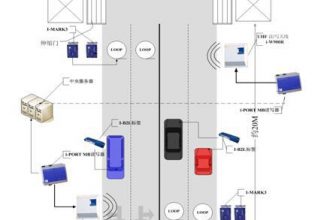
RFID mobile handheld terminal police industry application
[ad_1]
Radio Frequency Identification (RFID) technology is an automatic identification and data acquisition technology based on wireless technology. Its application began with the identification of friendly aircraft during World War II. With the maturity and development of computer information technology and VLSI technology, radio frequency identification technology has developed rapidly in various fields.

1 The main application of RFID technology in the field of military logistics
At present, the application of radio frequency identification technology in the military logistics field mainly focuses on the monitoring of the location and status of equipment and materials during transportation, storage management, and the search and distribution of specific items.
(1) Visualized management of equipment and materials in transit. That is, install radio frequency tags on containers or trailers loaded with large equipment and containers. At the same time, fixed or hand-held radio frequency readers and background computer systems are installed at the starting point, the end of the transportation, and the transit stations. When the container or transportation vehicle with the radio frequency tag passes by, the radio frequency reader reads the information stored in the radio frequency tag and transmits it to the background computer system for storage and display. If necessary, the radio frequency reader can also update the content on the radio frequency tag according to the instructions. The computer system transmits equipment and material information to a higher-level central database via wired, wireless networks or communication satellites, and logistics personnel and related units at all levels can obtain the location, quantity changes, and goods of all materials in transit in time through this database. Information such as damage and supplementary changes.
(2) Warehouse management in the place of material assembly. In addition to applications such as tracking the location, quantity, and condition of goods during transportation, radio frequency identification technology also plays an important role in the storage management of temporarily opened field cargo yards and various permanent cargo warehouses in material gathering places. In temporary field goods yards and various permanent warehouse materials storage operations, material transfer, stowage and distribution, repackaging, shelf management, etc., radio frequency identification technology and bar code technology can also perform their functions of recording information and identifying goods, and It has the advantages of longer working distance and easier operation than the optical reading of bar codes.
(3) A system for finding specific items. In temporary cargo staging areas or general warehouses, when an item needs to be found, the operator activates the handheld radio frequency reader to emit radio frequency electromagnetic waves to activate the tag, and the radio frequency tag installed on the container or pallet will respond and send a bee. The sound or flashing lights indicate the location of the item, and the item information is fed back to the radio frequency reader. The operator can find the container by sound and light. If the acousto-optic prompt fails or is not suitable for acousto-optic prompts (such as in a noisy environment or under acousto-optic control), you can also use the built-in positioning device of the handheld radio frequency reader to find it.
(4) Item distribution device. Radio frequency identification devices can also be used for the distribution and management of personal and daily necessities. In the past, the U.S. military used barcode technology to distribute clothing. Clothing companies affixed barcodes to uniforms and combat uniforms that needed to be distributed and sent them to conscription centers or camps. When recruits try on, the administrator scans the labels with a scanner, and inputs information such as the size, color, and style of combat uniforms suitable for the recruits into the computer. The computer transmits the information to the National Defense Forces Support Center, and then from the center to the clothing company. Used to make production plans. Applying radio frequency identification technology to the distribution of items such as clothing and medicines, procedures that used to be completed in multiple steps can be completed at one time, which saves manpower and improves efficiency.
The application of RFID technology in the military logistics field has effectively improved support efficiency, improved material tracking capabilities, inventory management capabilities, and labor productivity, greatly reduced repeated applications and item losses, and optimized internal business processes. According to estimates by the U.S. Department of Defense, the use of radio frequency identification technology can save more than 100 million U.S. dollars in logistics operation costs each year, and can use 1 billion U.S. dollars worth of inventory materials internally, which can greatly save purchase costs, transportation costs and maintenance. fee. The Israeli Army also claimed that the use of radio frequency identification technology has greatly reduced the cost of the Israeli army’s logistics supply and achieved the full tracking of equipment and material supplies.
2 Problems in the application of radio frequency identification technology in military logistics
From the analysis of public data, radio frequency identification technology plays an important role in improving the efficiency of logistics, which can improve operational capabilities, optimize processes, and save manpower and material resources. However, with the in-depth application of radio frequency identification technology in practice, some problems have gradually been exposed. Wal-Mart’s plan to adopt RFID was postponed from the original January 1, 2005 to mid-2005, and finally only required suppliers to put electronic tags on 65% of their products. The U.S. Department of Defense, which actively promotes the application of radio frequency identification technology, is also faced with various questions such as lack of detailed and feasible development strategies, difficulties in system integration, and unclear investment benefits. As a result, various U.S. services have expressed their worries about return on investment on different occasions and are unwilling. Provide financial support for RFID projects. At the same time, the continuous exposure of RFID reliability, system integration, and the maturity of the technology itself all prove that the application of RFID technology is not smooth. In the field of military logistics, there are still many technical problems that need to be solved urgently in the application of radio frequency technology, from label failure to external environment such as temperature and humidity causing the label to be unreadable, to radio frequency interference and so on. The resolution of these problems will directly affect the full application of radio frequency identification technology in the military logistics field.
(1) The problem of labeling. The performance, reliability, and manufacturing process of RFID active tags are relatively mature, but due to their high value, their use range is limited. The cost of passive tags is relatively low, but its performance and reliability need to be improved. The volume of the active tag and the capacity of the battery are issues that users care about. There is a trade-off between the suitability, strength, and cost of the substrate used in passive tags. According to a survey conducted by a research institution on passive label suppliers in 2005, 30% of the labels were damaged when the antenna was pasted, and another 10%-15% were damaged during the printing process. The read rate of passive tags has been bothering users.
(2) Frequency selection and usage issues. The frequency used by the radio frequency identification system will directly affect the system’s read and write distance, implementation standards, and compatibility issues. The logistics field usually uses ultra-high frequency (UHF) systems based on 433MHz, 915MHz and other frequency bands and 13.56MHz high frequency (HF) systems. In the UHF system, the read-write distance of active tags can reach 100 meters, and that of passive tags is about three to four meters. The reading and writing distance of a high-frequency system is generally tens of centimeters.
(3) The power problem of the radio frequency reader.
(4) Anti-jamming problem in complex electromagnetic environment.
(5) Information security issues. The radio signal on which the radio frequency identification system is based is transmitted and received in an “open” manner, and the radio wave itself cannot identify friend or foe. We use RFID to transmit information, and the enemy can also use this technology to obtain data, and even know the specific location and whereabouts of equipment and materials. Although the radiated power, radiation direction, spectrum band and information encryption of the radio frequency reader can be used to ensure the security of the system, it is very easy to attack any wireless system. The security threats to the RFID system in actual applications may come from three links: the communication from the tag to the radio frequency reader; the communication from the radio frequency reader to the back-end computer system; and the back-end databases that exchange data using public networks Information transmission. In the U.S. Department of Defense’s policy guidelines for the use of radio frequency tags issued in August 2004, data encryption on passive tags is not required. One of the reasons is that the information on the tag is just a serial number, which has no meaning if it is not connected to the database. The second reason is that potential enemies cannot approach the tag for reading. It should be noted that this assumption is premised.
(6) On-site use of special goods.
(7) System compatibility issues. Only by fully integrating the radio frequency identification system with the existing computer information system can the technical advantages of RFID be brought into play and the effectiveness of the military supply chain can be truly improved. The compatibility of the radio frequency identification system is embodied in three aspects: First, the format and standard of the data collected and processed by the radio frequency identification system must be unified with the existing computer system. With the efforts of organizations such as the Automatic Identification Center of the US Department of Defense, the US military has realized the standardization of information on RFID chips and formulated fully compatible EPC-96, EPC-128 DOD-96, and DOD-128 information standards. However, the standards established are not compatible with the current information systems of the Department of Defense. Second, the compatibility between RF readers and RF tags of different designs. At the same frequency, the radio frequency reader is best able to read radio frequency tags of different designs. Third, the compatibility between radio frequency identification systems of different frequency bands, it is best to use the same radio frequency identification system to be compatible with radio frequency tags of several frequency bands. These two compatibility can be solved by administrative measures to ensure that the tags and readers used are the products of the same supplier, or the use of a set of frequency radio frequency identification systems in the logistics supply chain, but due to various frequency bands The system has its own advantages and shortcomings. What users want more is a set of radio frequency identification systems compatible with the main application frequency bands and suitable for different types of tags. Fundamentally speaking, the key to truly affecting the large-scale application of RFID and reducing costs is the openness of standards and the compatibility between systems.
(8) Problems caused by the natural environment.
The above problems are interrelated. The solution of one problem may provide opportunities for other problems, but it may bring new problems. The application of RFID systems is a process of constant weighing in technology, cost, safety, compatibility, and reliability. It should be realized that the use of any new technology will not be smooth sailing. It is believed that with the gradual deepening of the application of radio frequency identification technology in the military logistics field, the problems continue to be exposed and continuously improved, and the application prospects are bright.
[ad_2]




